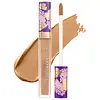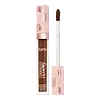What's inside
What's inside
 Key Ingredients
Key Ingredients

 Benefits
Benefits

 Concerns
Concerns

No concerns
 Ingredients Side-by-side
Ingredients Side-by-side

Caprylic/Capric Triglyceride
MaskingBis-Diglyceryl Polyacyladipate-2
EmollientCetyl Alcohol
EmollientVp/Hexadecene Copolymer
Silica Dimethyl Silylate
EmollientAluminum Hydroxide
EmollientAscorbyl Palmitate
AntioxidantPassiflora Edulis Seed Oil
EmollientTocopherol
AntioxidantMicrocrystalline Wax
Emulsion StabilisingPhenoxyethanol
PreservativeTocopheryl Acetate
AntioxidantCaprylyl Glycol
EmollientKaolin
AbrasiveCI 77891
Cosmetic ColorantIron Oxides
Caprylic/Capric Triglyceride, Bis-Diglyceryl Polyacyladipate-2, Cetyl Alcohol, Vp/Hexadecene Copolymer, Silica Dimethyl Silylate, Aluminum Hydroxide, Ascorbyl Palmitate, Passiflora Edulis Seed Oil, Tocopherol, Microcrystalline Wax, Phenoxyethanol, Tocopheryl Acetate, Caprylyl Glycol, Kaolin, CI 77891, Iron Oxides
Water
Skin ConditioningCyclopentasiloxane
EmollientGlycerin
HumectantPolymethylsilsesquioxane
PEG-9 Polydimethylsiloxyethyl Dimethicone
EmulsifyingCaprylic/Capric Triglyceride
MaskingCaprylyl Methicone
Skin ConditioningC13-15 Alkane
SolventSorbitan Isostearate
EmulsifyingDimethicone
EmollientPhenyl Trimethicone
Skin ConditioningAcrylates/Stearyl Acrylate/Dimethicone Methacrylate Copolymer
Kaolin
AbrasiveNiacinamide
SmoothingPassiflora Edulis Seed Oil
EmollientBakuchiol
AntimicrobialCaffeine
Skin ConditioningHydrolyzed Vegetable Protein
Skin ConditioningVitis Vinifera Seed Oil
EmollientRubus Chamaemorus Fruit Extract
AntioxidantTocopherol
AntioxidantSodium Hyaluronate
HumectantAloe Barbadensis Leaf Extract
EmollientCitrullus Lanatus Fruit Extract
Skin ConditioningCitrus Limon Fruit Extract
MaskingEuterpe Oleracea Fruit Extract
Fragaria Vesca Fruit Extract
AstringentLycium Barbarum Fruit Extract
AstringentMalpighia Punicifolia Fruit Extract
AntioxidantPassiflora Incarnata Fruit Extract
Skin ConditioningPrunus Persica Fruit Extract
AbrasivePunica Granatum Fruit Extract
AntioxidantVaccinium Angustifolium Fruit Extract
Skin ProtectingVaccinium Macrocarpon Fruit Extract
AstringentDiamond Powder
AbrasiveTocopheryl Acetate
AntioxidantPhenoxyethanol
PreservativeHydroxyethyl Urea
HumectantMagnesium Sulfate
Isotridecyl Isononanoate
EmollientDisteardimonium Hectorite
StabilisingDimethicone Crosspolymer
Emulsion StabilisingCetyl PEG/PPG-10/1 Dimethicone
EmulsifyingPolypropylsilsesquioxane
Quaternium-90 Bentonite
Aluminum Hydroxide
EmollientTriethoxycaprylylsilane
Ethylhexylglycerin
Skin ConditioningTriethyl Citrate
MaskingPolyhydroxystearic Acid
EmulsifyingPropylene Carbonate
SolventEthylhexyl Palmitate
EmollientIsopropyl Myristate
EmollientIsostearic Acid
CleansingLecithin
EmollientDisodium EDTA
Polyglyceryl-3 Polyricinoleate
EmulsifyingPentaerythrityl Tetra-Di-T-Butyl Hydroxyhydrocinnamate
AntioxidantLeuconostoc/Radish Root Ferment Filtrate
AntimicrobialButylene Glycol
Humectant1,2-Hexanediol
Skin ConditioningTitanium Dioxide
Cosmetic ColorantCI 77491
Cosmetic ColorantCI 77492
Cosmetic ColorantCI 77499
Cosmetic ColorantWater, Cyclopentasiloxane, Glycerin, Polymethylsilsesquioxane, PEG-9 Polydimethylsiloxyethyl Dimethicone, Caprylic/Capric Triglyceride, Caprylyl Methicone, C13-15 Alkane, Sorbitan Isostearate, Dimethicone, Phenyl Trimethicone, Acrylates/Stearyl Acrylate/Dimethicone Methacrylate Copolymer, Kaolin, Niacinamide, Passiflora Edulis Seed Oil, Bakuchiol, Caffeine, Hydrolyzed Vegetable Protein, Vitis Vinifera Seed Oil, Rubus Chamaemorus Fruit Extract, Tocopherol, Sodium Hyaluronate, Aloe Barbadensis Leaf Extract, Citrullus Lanatus Fruit Extract, Citrus Limon Fruit Extract, Euterpe Oleracea Fruit Extract, Fragaria Vesca Fruit Extract, Lycium Barbarum Fruit Extract, Malpighia Punicifolia Fruit Extract, Passiflora Incarnata Fruit Extract, Prunus Persica Fruit Extract, Punica Granatum Fruit Extract, Vaccinium Angustifolium Fruit Extract, Vaccinium Macrocarpon Fruit Extract, Diamond Powder, Tocopheryl Acetate, Phenoxyethanol, Hydroxyethyl Urea, Magnesium Sulfate, Isotridecyl Isononanoate, Disteardimonium Hectorite, Dimethicone Crosspolymer, Cetyl PEG/PPG-10/1 Dimethicone, Polypropylsilsesquioxane, Quaternium-90 Bentonite, Aluminum Hydroxide, Triethoxycaprylylsilane, Ethylhexylglycerin, Triethyl Citrate, Polyhydroxystearic Acid, Propylene Carbonate, Ethylhexyl Palmitate, Isopropyl Myristate, Isostearic Acid, Lecithin, Disodium EDTA, Polyglyceryl-3 Polyricinoleate, Pentaerythrityl Tetra-Di-T-Butyl Hydroxyhydrocinnamate, Leuconostoc/Radish Root Ferment Filtrate, Butylene Glycol, 1,2-Hexanediol, Titanium Dioxide, CI 77491, CI 77492, CI 77499
 Reviews
Reviews

Ingredients Explained
These ingredients are found in both products.
Ingredients higher up in an ingredient list are typically present in a larger amount.
Aluminum Hydroxide is a form of aluminum. It can be naturally found in nature as the mineral gibbsite. In cosmetics, Aluminum Hydroxide is used as a colorant, pH adjuster, and absorbent.
As a colorant, Aluminum Hydroxide may add opacity, or reduce the transparency. Aluminum hydroxide is contains both basic and acidic properties.
According to manufacturers, this ingredient is an emollient and humectant. This means it helps hydrate the skin.
In medicine, this ingredient is used to help relieve heartburn and help heal ulcers.
There is currently no credible scientific evidence linking aluminum hydroxide in cosmetics to increased cancer risk.
Major health organizations allow the use of aluminum hydroxide in personal care products and have not flagged it as a carcinogenic risk at typical usage levels.
Learn more about Aluminum HydroxideThis ingredient is an emollient, solvent, and texture enhancer. It is considered a skin-softener by helping the skin prevent moisture loss.
It helps thicken a product's formula and makes it easier to spread by dissolving clumping compounds.
Caprylic Triglyceride is made by combining glycerin with coconut oil, forming a clear liquid.
While there is an assumption Caprylic Triglyceride can clog pores due to it being derived from coconut oil, there is no research supporting this.
Learn more about Caprylic/Capric TriglycerideKaolin is a clay. It is used for oil control and to help minimize pores. Like other clays, kaolin has the ability to absorb excess sebum or oil. This can help clean out pores and mattify the skin.
Some types of kaolin may have exfoliating properties. When water is added to kaolin, it becomes a paste with small abrasive particles.
Most kaolin is a white color, but may be pink/orange/red depending on where it comes from.
The name 'kaolin' comes from a Chinese village named 'Gaoling'. Kaolin clay comes from rocks rich in kaolinite. Kaolinite, the mineral, has a silicate layered structure. Kaolinite is formed from chemical weathering of aluminum siilicate minerals.
Besides skincare, kaolin is commonly used to make glossy paper, in ceramics, toothpaste, and as medicine to soothe stomach issues.
Learn more about KaolinPassiflora Edulis Seed Oil is an oil and isn't fungal acne safe.
Phenoxyethanol is a preservative that has germicide, antimicrobial, and aromatic properties. Studies show that phenoxyethanol can prevent microbial growth. By itself, it has a scent that is similar to that of a rose.
It's often used in formulations along with Caprylyl Glycol to preserve the shelf life of products.
Tocopherol (also known as Vitamin E) is a common antioxidant used to help protect the skin from free-radicals and strengthen the skin barrier. It's also fat soluble - this means our skin is great at absorbing it.
Vitamin E also helps keep your natural skin lipids healthy. Your lipid skin barrier naturally consists of lipids, ceramides, and fatty acids. Vitamin E offers extra protection for your skin’s lipid barrier, keeping your skin healthy and nourished.
Another benefit is a bit of UV protection. Vitamin E helps reduce the damage caused by UVB rays. (It should not replace your sunscreen). Combining it with Vitamin C can decrease sunburned cells and hyperpigmentation after UV exposure.
You might have noticed Vitamin E + C often paired together. This is because it is great at stabilizing Vitamin C. Using the two together helps increase the effectiveness of both ingredients.
There are often claims that Vitamin E can reduce/prevent scarring, but these claims haven't been confirmed by scientific research.
Learn more about TocopherolTocopheryl Acetate is AKA Vitamin E. It is an antioxidant and protects your skin from free radicals. Free radicals damage the skin by breaking down collagen.
One study found using Tocopheryl Acetate with Vitamin C decreased the number of sunburned cells.
Tocopheryl Acetate is commonly found in both skincare and dietary supplements.
Learn more about Tocopheryl Acetate